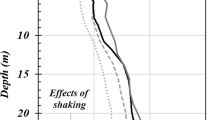Abstract
This study attempts to propose dynamic centrifuge model tests as a method of seismic risk assessment in order to discover how stone architectural heritages with masonry structures have endured seismic load, and whether there is any possibility of future earthquake damage. Dynamic centrifuge tests have been conducted for one fifteenth scale models of Seok-ga-tap and the five-storey stone pagoda of Jeongnimsa temple site, which are Korean representative stone pagodas. In order to make input motions of the earthquake simulator, site investigation and site-specific response analysis have been performed. The models of two stone pagodas, which have the same number of pieces with the real structures, have been produced and the dynamic centrifuge tests have been conducted for the model pagodas. Accelerometers were attached at different heights of the pagoda. The measured acceleration records and frequency responses were analysed during dynamic centrifuge test. Two real earthquake records, Hachinohe and Ofunato earthquakes and a sweeping signal with ranged frequency were utilised for input motions of dynamic centrifuge tests to evaluate the behaviour of the stone pagodas. For Seok-ga-tap models, it was observed that acceleration tends to be amplified with height. The third floor body shows at most 2.5 amplification of acceleration in comparison to the surface ground. The amplification was at a frequency of 3.83 Hz and it was considered as the natural frequency of the pagoda. For the five-storey stone pagoda, the seismic wave energy significantly reduced while it passed the first body floor, and then the peak acceleration was gradually amplified upwards. It was found that the pagodas did not collapse when the peak acceleration of ground surface was raised to 0.4 g. Given that the maximum design seismic acceleration specified in Korean seismic design guide is 0.22 g and the amplification ratio of peak acceleration in the supporting ground of the pagodas ranges from 1.45 to 1.74, it can be shown that the two pagodas are stable against 2400-year return period earthquake level, and have excellent seismic performance.












Similar content being viewed by others

References
Buyeo-gun (2009) Safety inspection of the five storied stone pagoda of Jeongnimsa temple site (in Korean)
Buyeo-gun and NRICH (National Research Institute of Cultural Heritage) (2009) Data survey for historical research and restoration of Jeongnimsa Temple site, Buyeo (in Korean)
Choi H (2002) A study on application of geophysical method for structural safety diagnosis of Dabo pagoda, Seogga pagoda at Bulguksa Temple. Master Thesis, Kongju National University (in Korean)
Dogangun A, Acar R, Sezen H, Livaoglu R (2008) Investigation of dynamic response of masonry minaret structures. Bull Earthq Eng 6:505–517. doi:10.1007/s10518-008-9066-5
Itasca Consulting Group (2001) FLAC 2D. Fast Lagrangian Analysis of Continua in 2 Dimensions. Version 4.0, User Manual, Minnea Police: Itasca
Kim J-K, Ryu H (2003) Seismic test of a full-scale model of a five-storey stone pagoda. Earthq Eng Struct Dyn 32(5):731–750. doi:10.1002/eqe.246
Kim D-S, Kim N-R, Choo Y-W, Cho G-C (2013a) A newly developed state-of-the-art geotechnical centrifuge in Korea. KSCE J Civil Eng 17(1):77–84. doi:10.1007/s12205-013-1350-5
Kim D-S, Lee S-H, Choo Y-W, Perdriat J (2013b) Self-balanced earthquake simulator on centrifuge and dynamic performance verification. KSCE J Civil Eng 17(4):651–661. doi:10.1007/s12205-013-1591-3
Konstantinidis D, Makris N (2005) Seismic response analysis of multidrum classical columns. Earthq Eng Struct Dyn 34(10):1243–1270. doi:10.1002/eqe.478
Lee S-H, Choo Y-W, Kim D-S (2013) Performance of an equivalent shear beam (ESB) model container for dynamic geotechnical centrifuge tests. Soil Dyn Earthq Eng 44:102–114. doi:10.1016/j.soildyn.2012.09.008
NRICH (National Research Institute of Cultural Heritage) (2007) Stone Stupa of Gyeongsangbuk-do I (in Korean)
Park H-J, Kim D-S (2013) Centrifuge modelling for evaluation of seismic behaviour of stone masonry structure. Soil Dyn Earthq Eng 53:187–195. doi:10.1016/j.soildyn.2013.06.010
Park H-J, Kim D-M, Kim K-S, Ahn H-Y, Kim D-S (2012) Noninvasive geotechnical site investigation for stability of Cheomseongdae. J Cult Heritage 13(1):98–102. doi:10.1016/j.culher.2011.05.008
Park H-J, Kim D-S, Kim D-M (2013) Seismic risk assessment of architectural heritages in Gyeongju considering local site effects. Nat Hazards Earth Syst Sci 13(2):251–262. doi:10.5194/nhess-13-251-2013
Schnabel PB, Lysmer J, Seed HB (1972) SHAKE: a computer program for earthquake response analysis of horizontally layered sites. Report EERC 72–12, Earthquake Engineering Research Center, University of California, Berkeley
Stokoe KH, Hwang SK, Roesset JM, SUN WS (1994) Laboratory measurements of small-strain material damping of soil using the free-free resonant column. Proceedings Earthquake Resistant Construction and Design, Berlin, Germany, Balkema, Rotterdam, pp 195–202
Taylor RN (1995) Geotechnical centrifuge technology. Blackie Academic and Professional, London
Youn J-U, Choo Y-W, Kim D-S (2008) Measurement of small-strain shear modulus Gmax of dry and saturated sands by bender element, resonant column, and torsional shear tests. Can Geotech J 45(10):1426–1438. doi:10.1139/T08-069
Acknowledgments
This research was supported by a Basic Science Research Program through the National Research Foundation of Korea (NRF) funded by the Ministry of Education, Science and Technology (Grant Number: 2009-0080575).This study, which forms a part of the project, has been achieved with the support of national R&D project, which has been hosted by National Research Institute of Cultural Heritage of Cultural Heritage Administration. We express our gratitude to it. The authors would like to thank Mr. Mu-Kwang Kim, Jeong-Gon Ha, Seong-Bae Jo, Jae-Hyun Kim, Hyung-Ik Cho and Ms. Sehee Kim for their advice and support in dynamic centrifuge testing.
Author information
Authors and Affiliations
Corresponding author
Rights and permissions
About this article
Cite this article
Park, HJ., Kim, DS. & Choo, Y.W. Evaluation of the seismic response of stone pagodas using centrifuge model tests. Bull Earthquake Eng 12, 2583–2606 (2014). https://doi.org/10.1007/s10518-014-9598-9
Received:
Accepted:
Published:
Issue Date:
DOI: https://doi.org/10.1007/s10518-014-9598-9


